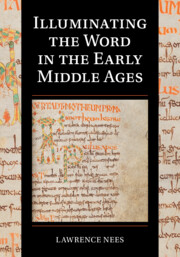Book contents
- Illuminating the Word in the Early Middle Ages
- Cambridge Studies in Palaeography and Codicology
- Additional material
- Illuminating the Word in the Early Middle Ages
- Copyright page
- Contents
- Figures
- Acknowledgments
- Abbreviations
- 1 The New Medieval Book and Its Heritage
- 2 The St. Petersburg Gregory Manuscript and Its Ornament
- 3 Seeing and Reading
- 4 Decorated Words in Late Antiquity
- 5 Illuminated Manuscripts from Luxeuil and Bobbio
- 6 Early Insular Manuscripts in Relation to the Beginnings of Book Illumination
- 7 The Beginnings of Book Illumination and the Ethnic Paradigm in Modern Historiography
- 8 Conclusion
- Bibliography
- Manuscript Index
- Subject Index
1 - The New Medieval Book and Its Heritage
Published online by Cambridge University Press: 14 September 2023
- Illuminating the Word in the Early Middle Ages
- Cambridge Studies in Palaeography and Codicology
- Additional material
- Illuminating the Word in the Early Middle Ages
- Copyright page
- Contents
- Figures
- Acknowledgments
- Abbreviations
- 1 The New Medieval Book and Its Heritage
- 2 The St. Petersburg Gregory Manuscript and Its Ornament
- 3 Seeing and Reading
- 4 Decorated Words in Late Antiquity
- 5 Illuminated Manuscripts from Luxeuil and Bobbio
- 6 Early Insular Manuscripts in Relation to the Beginnings of Book Illumination
- 7 The Beginnings of Book Illumination and the Ethnic Paradigm in Modern Historiography
- 8 Conclusion
- Bibliography
- Manuscript Index
- Subject Index
Summary
What makes early medieval manuscripts so special, and so influential for subsequent book production, with many of their features continuing through the adoption of the revolution of printing and through the early stages of the digital revolution? So much of our writing culture is taken for granted, such as the deployment of different letter forms, fonts, or different colors for different aspects of a text, beginning a new sentence with a capital letter followed by others in “lowercase” minuscule, ending the sentence with a period, and arguing about where one ought to put commas, or indent for new paragraphs. We do not argue about not running a word from the end of one line to the beginning of the next by inserting a hyphen, about putting spaces between words, or about navigating in the text with page numbers, all things assumed rather than noticed. With the exception of the last, strangely absent, most of these features were innovations of the early medieval period that are still in use, and largely taken for granted. Spaces between words? Look at your keyboard. Which key is largest? The space bar is largest by far, and centrally placed, because most often used. The notion of separating words seems so natural, as inevitable as the wheel, that its origin in the early medieval period is little known, as is its general absence in earlier writing cultures, certainly in the Greek and Roman world. Some of these features existed before the early medieval period. For example, the mostly Hebrew and Aramaic finds at Qumran, the “Dead Sea scrolls,” commonly separated words by spaces.
- Type
- Chapter
- Information
- Illuminating the Word in the Early Middle Ages , pp. 1 - 41Publisher: Cambridge University PressPrint publication year: 2023



